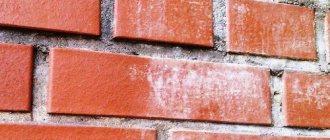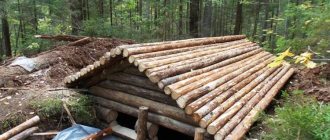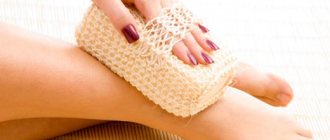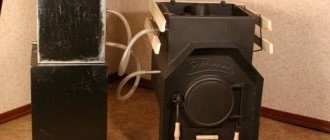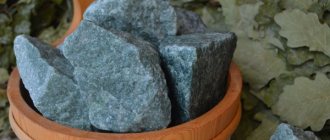Those who have a summer house probably dream of or have already acquired a bathhouse. This building is classified as a fire hazard. It has a stove that allows you to heat the sauna to the desired temperature and steam. Sometimes people who built on their own did not think through the safety and security of the building well. Today there are many materials that will protect a wooden house from fire. One of them is a mineralite slab. You can't find better material for a bathhouse. Let's consider its features and technical characteristics.
Why do they trust us?
1. No prepayment.Staged payment for results.
2. We do it on time or for free.Construction is divided into stages with a specified completion date.
3. No hidden fees.The price is final at the contract stage.
4. "Full construction".All work is done by one company.
Types of materials for thermal insulation
Additional protection of wood from the high temperature of the stove must be done if the stove is located at a distance of less than 1 meter from the wall. When choosing a material for such insulation, you need to pay attention to:
- efficiency;
- environmental safety.
Based on these criteria, the most popular materials for such finishing of the stove location in the bathhouse are:
- superizol;
- minerite;
- stainless steel;
- fire-resistant plasterboard;
- brickwork.
Types and sizes
There are not many varieties of mineralite, but they exist, which makes it possible to isolate the material for a specific area of application. For example, decorative mineralite , labeled “Pastel”, has a polished smooth surface and is used for finishing facades. The “PC” variety, more than other options, is represented by a wide variety of colors. Also suitable for facade and interior work.
The variety labeled “HD” is most often used in its pure form, where aesthetics are not so important. Its price is lower, but its technical characteristics are in no way inferior in quality to other varieties.
Minerite size
In addition, the “HD” series reserves the right for the buyer to independently choose the paint and apply it if necessary. The main thing to remember is that if you are going to use the material in finishing areas near flammable areas, it is important to use fire-resistant types of paints.
The “VZ” variety is aimed at facade work, and the main goal is to protect the building from moisture and wind. The dimensions and thickness of products are individual and, basically, they depend on the manufacturer.
Facade finishing is characterized by slabs measuring 60 by 30 cm, with a slab thickness of 8 mm. A mineralite slab 6 mm thick is also suitable for interior work Its sizes are individual and can have different shapes, including mineralite like a brick. On average, the dimensions of the panels can be 60 by 120 cm.
Fireproof plasterboard
You can protect the walls in the bathhouse from the heat of the stove using gypsum plasterboard. This material has the following characteristics:
- withstands extreme heat;
- does not support open flame.
Such characteristics of the material are made possible due to its composition.
Unlike conventional drywall, fire-resistant sheets contain special glass fibers that prevent the destruction of the material. Porcelain stoneware slabs can be laid on the surface of the drywall.
Characteristics and composition
Before talking about the characteristics of the product, we should understand what we are dealing with, namely, talk about the composition. It may change from manufacturer to manufacturer, but the essence remains the same. The main component of mineralite is cement.
It is at least 70% here. The rest is taken up by cellulose, as well as special additives. Despite the appearance and overall strength of the product, mineralite does not contain asbestos. This means that when heated, not a single gram of harmful substances is released, and destruction is also excluded.
Asbestos is known to even explode at critical temperatures. All products must include hydrobisifiers. These are special elements that protect the structure from moisture absorption, which prevents cracking in frosts, possible rotting and other types of damage.
Now, it's time to move on to the characteristics. Let's list the most important of them:
- High strength. This applies not only to exposure to shocks and external damage, but also to the effect of moisture on the surface when it is heated to a high degree, for example, in a bathhouse, as well as resistance to temperature changes and air humidity levels. The surface and structure as a whole are resistant to humidity levels, which expands the scope of use even to outdoor use.
- Does not burn. Manufacturers of mineralite indicate the class “NG”, which indicates the complete non-flammability of the product. This makes its scope wide and not limited only to saunas and baths.
- Invariance under various influencing factors. As previously mentioned, water repellents prevent moisture from getting inside. As for low/high temperatures, in the range from -100 to + 180, the structure does not react in any way, including the properties of linear expansion remain unchanged. The product is also resistant to chemically active environments, which is why mineralite is often used in the finishing of industrial premises.
- Stronger every day. We said that 70 percent of the material is cement. Thus, the more time passes from the date of production, the stronger the product becomes. And this continues for at least 50-70 years, after which the cement will lose its properties with the same uniformity.
- Environmentally friendly. Judge for yourself: cement, sand, cellulose and other mineral additives cannot harm humans and others. Thus, it is completely safe under any conditions.
As you can see, there are many characteristics that will become important and fundamental when choosing. But we must not forget about the fragility of products. The material is very fragile, so it must be transported, stored and stored with extreme caution.
The same applies to processing. It cuts softly, you can use a hand or power tool, but to achieve the best result it is best to use cutting elements with a fine tooth.
Prices for the construction of baths, houses
Construction of houses, baths
| Log houses | from 9 thousand/m2 - two-story, from 13 thousand/m2 - one-story |
| Houses made of laminated veneer lumber | from 14 thousand/m2 - two-story, from 17 thousand/m2 - one-story |
| Log baths | from 9500 rub/m2 |
| Baths made of profiled timber | from 12600 rub/m2 |
| Bathhouses made of laminated dry timber | from 16,000 rub/m2 |
| Brick baths | from 19,000 rub/m2 |
| Baths made of gas-foam blocks | from 12600 rub/m2 |
| Baths using frame technology | from 9000 rub/m2 |
| Baths made of SIP panels | from 9650 rub/m2 |
Construction of the foundation
| Strip foundation | from 3400 rub/m.p. |
| Monolithic foundation (slab) | from 4200rub/m2 |
| Pile-screw foundation | from 3200rub/piece |
| Columnar foundation | from 3800rub/piece |
Roof installation
| Installation of vapor barrier | 60rub/m2 |
| Installation of insulation in 1 layer | 60rub/m2 |
| Metal tiles | from 280rub/m2 |
| Flexible tiles (bitumen) | from 300rub/m2 |
| Corrugated sheets (euro slate) | from 200rub/m2 |
| Natural tiles | from 400rub/m2 |
| Seam roofing | from 350rub/m2 |
| Corrugated sheet | from 250rub/m2 |
| Drainage system | from 350 RUR/m.p. |
Floor installation
| "Heated floor" device | from 450rub/m2 |
| Treating the screed with a primer (moisture protection, dust removal) | from 30rub/m2 |
| Floor joist installation | from 180rub/m2 |
| Leveling and strengthening the floor beams to the level (if they were installed previously) | from 80rub/m2 |
| Installation of subfloors from edged boards | from 100rub/m2 |
| Installation of vapor barrier | from 50rub/m2 |
| Insulation (per 1 layer 50 mm) | from 50rub/m2 |
| Laying floor boards | from 300rub/m2 |
Additionally
| Installation of internal electrical panel | from 3800rub/piece |
| Plywood sheathing, OSB | from 260rub/m2 |
| Installing an electrical kit inside the bathhouse | from 7000rub |
Minerite
Heat-resistant material from the Finnish company Cembrit Oy.” It includes:
- white cement;
- mineral fillers;
- reinforcing fiber.
Minerite contains no substances or compounds hazardous to health. Therefore, it is ideal for a bath. You can protect the walls from the destructive heat of the furnace with this material using ceramic fasteners. It allows you to leave an additional gap between the Minerite sheet and the wall. If the distance between the stove and the wall does not allow mounting this material with a gap, then it is advisable to install two sheets of Minerite on top of each other.
What is minerite?
Minerite is a product that can hardly be called a building material. It does not have super strength, which would allow it to be used as elements of a supporting structure. But, at the same time, it is based on a cement mixture, which means it gets stronger every day, at least 50 years of complete drying at the time of production.
Practice shows that many people choose this product due to its non-flammability properties. Thus, it is relevant for baths and saunas, where a stove is installed near the tree or heating elements pass through.
Here, refractory mineralite is a slab designed to operate within a temperature range of -100 to 180 degrees Celsius, which expands the range of use in different areas of the world.
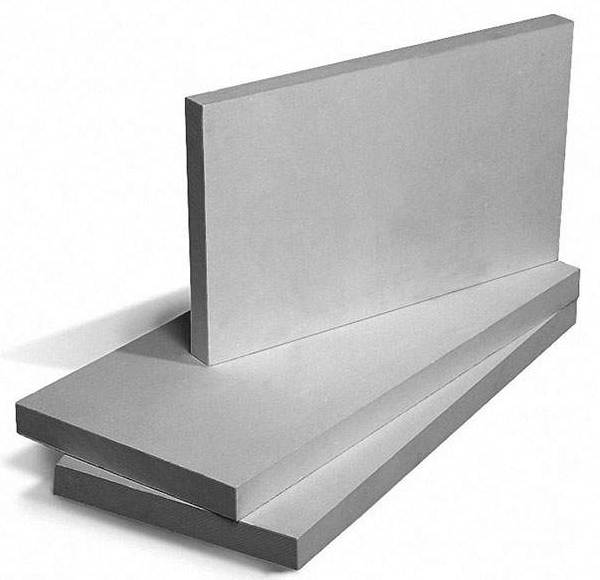
Fireproof mineralite plate
When heated, the surface of the plate does not react in any way, including cracking, deforming and losing its properties. When used in a steam room, mineralite slabs easily withstand moisture, even when they are heated to the limit.
But the area of application described above is not the only one. Due to its lightness and strength, resistance to moisture, mineralite can be used in cladding the facades of buildings.
The latter is facilitated by modern production technologies, which make it possible to paint in different shades. The installation method can be different and, depending on the purpose, the material can be easily attached to both vertical and horizontal surfaces. Ceiling mounting is allowed.
Heat resistant tiles
Today you can buy special tiles on the building materials market. Fire-resistant versions of this finishing material are made from clay without the addition of dyes and other chemical additives. The advantage of such tiles:
- versatility of the material;
- large range of colors;
- high strength and durability;
- ability to withstand high temperatures.
To lay such tiles, special heat-resistant adhesives and grouts are used.
All the materials listed in this article have proven themselves to be effective in protecting the wooden elements of a bathhouse from heat.
The most cost-effective solution is to create an additional brick wall in the area where the hot furnace is located. Such a wall can be built from gypsum and lined with heat-resistant tiles.
Still have questions? Ask them to a specialist, leaving your number in the form.
Application
The scope of application is extensive and covers the sphere of private and capital construction. Let's look at the main areas:
- Instead of asbestos. Asbestos releases substances harmful to people that can make people feel worse. Therefore, when exposed to high temperatures, mineralite is used. And these are baths, saunas, Russian stoves, industrial premises where a high fire safety limit is required. By the way, the “LV” series, which was not previously mentioned, is suitable for saunas. It is lightweight, has many color options, does not burn and can withstand temperatures up to 180 degrees Celsius. The material showed itself to be absolutely normal in matters of zoning application.
- Where it is damp and humid. These can be basements and semi-basements, washing rooms in bathhouses, bathrooms, rooms near swimming pools. Minerite for baths not only does not deteriorate from moisture and protects the surface of load-bearing walls from destruction, but also prevents the formation of fungus and mold. At the same time, if you have a wooden house, then the surface of the walls can be covered with mineralite, and tiles and porcelain stoneware can be laid on it without additional insulation from water. You can do the same in the kitchen, and then hang wallpaper.
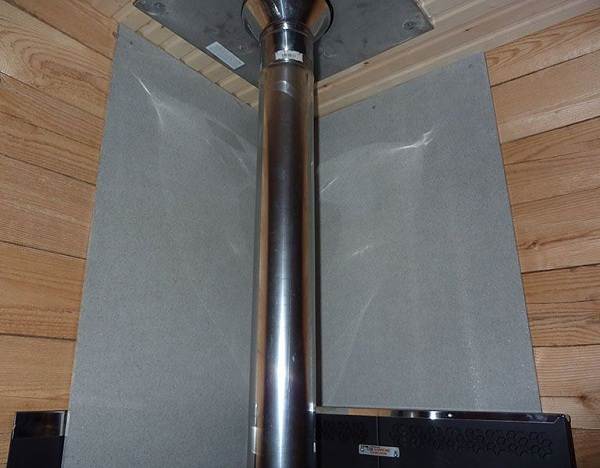
Protection of a chimney in a bathhouse with mineralite
The scope of application of such finishing options is so diverse that it covers the private sphere and permanent buildings. For example, mineralite is used to decorate the exterior facades of houses, to create safety zones inside baths and saunas, even in houses where there are full-fledged fireplaces. In particular, mineralite can be used for finishing utility rooms, loggias, balconies and other places. The variety with the “RK marking” is suitable for finishing facades.
